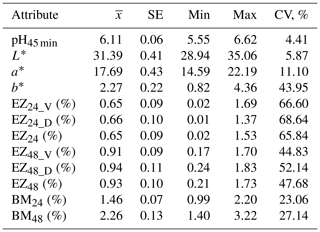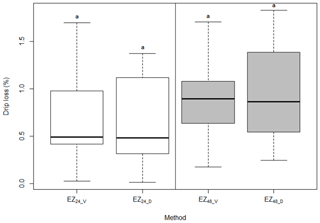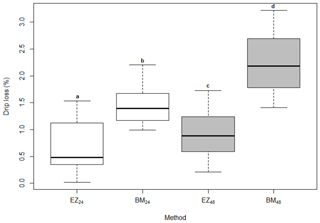Drip loss assessment by EZ and bag methods and their relationship with pH value and color in mutton
Drip loss, pH value, and color are among the important traits that determine meat quality. Contrary to pH and color, the method associated with drip loss is not yet standardized, and literature data are difficult to compare. Besides, to our knowledge, there is no research comparing drip loss methods and their relation with pH and color in mutton. This study aimed to assess drip loss measurements in mutton taken by different methods (EZ and bag – BM) and their relationship with pH values and color. Mutton samples (Musculus longissimus thoracis et lumborum) originating from 20 ewes of Istrian sheep were used to examine the effect of the method on drip loss after 24 h (EZ24 vs. BM24) and 48 h (EZ48 vs. BM48). Furthermore, correlations between drip loss, pH value, and color were analyzed. The statistical analysis was conducted in R programming environment by using different packages. Within the EZ method there was no significant difference (p>0.05) between ventral and dorsal sample cores used for the assessment of EZ drip loss. Drip loss measured with the same method at two different points of time (24 and 48 h) differed significantly (p<0.001). There was also a significant difference in drip loss determined by different methods (EZ vs. BM) at the same point of time. There were significant (p<0.05) correlations between pH45 min and all color parameters (L*4, a*, b*). The L*, a*, and b* parameters were highly correlated (p<0.001). The strongest correlation occurred between a* and b* parameter (r=0.93). Correlations between drip loss by EZ method and other meat quality attributes were low and not significant. The b* parameter correlated with BM24 (r=0.46) and BM48 (r=0.58), while a* correlated only with BM48 (r=0.50). The correlations between the EZ24 and BM24 as well as between the EZ48 and BM48 were both non-significant (p>0.05). Drip loss cannot be predicted with sufficient accuracy by using pH and color. EZ and BM method in mutton do not provide equivalent results for measuring drip loss. Comparisons of the results obtained with different methods should be avoided or at least performed with great precaution.









